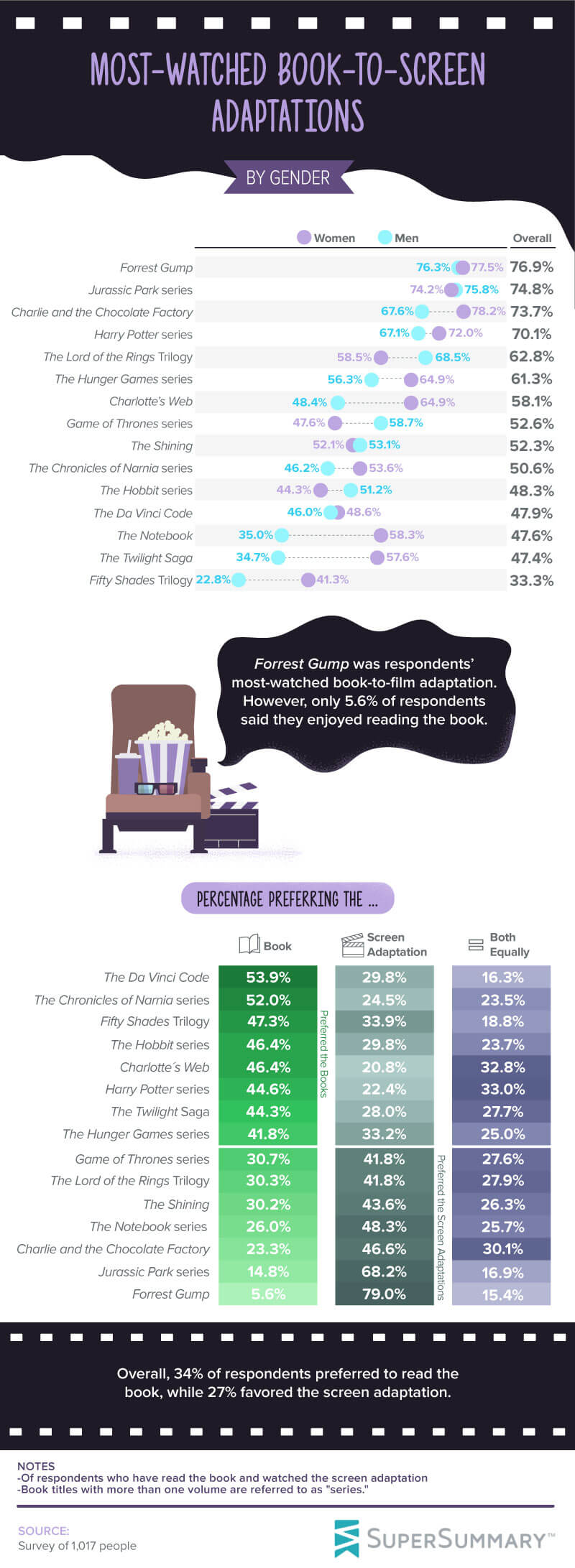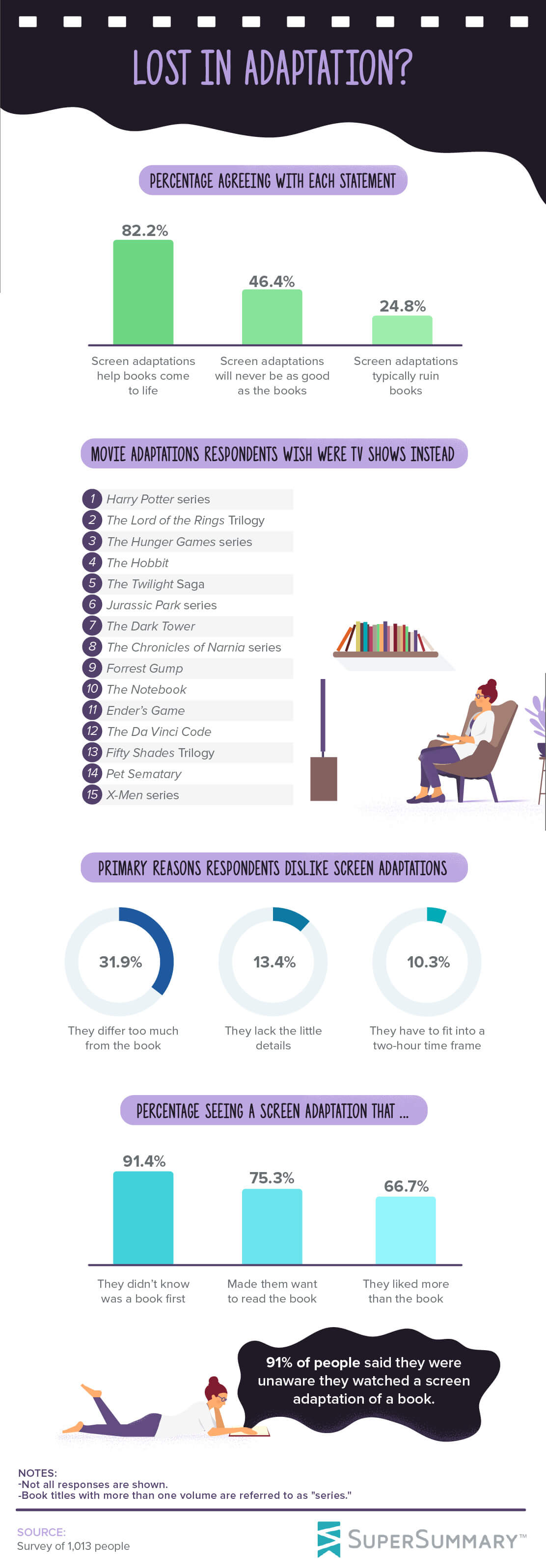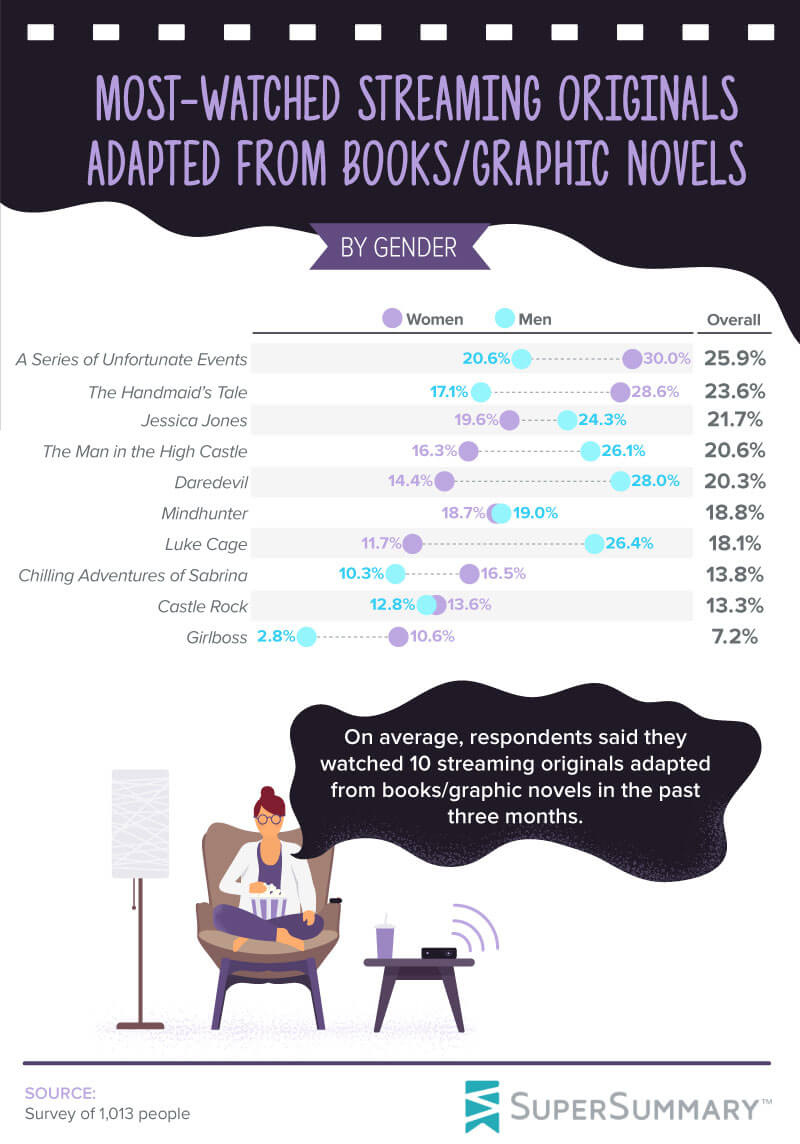from fiction to film
Exploring Perceptions of Book-to-Screen Adaptations

It’s become increasingly common to see a trailer for a movie or TV series that was first a beloved book. In some cases, the screen adaptations are more popular, and much of the public might not even know a fan-favorite film was initially a book.
To better understand which book-to-screen adaptations entertainment lovers cherish, we surveyed more than 1,000 people who enjoyed reading or watching screen adaptations. Our findings reveal the most-watched shows and films among participants and how they feel about the literary versions.
Popular Screen Adaptations, by Gender
Before Tom Hanks played America’s favorite neighbor, Mister Rogers, he won his second Oscar for Forrest Gump. At the 67th Academy Awards in 1995, Mr. Hanks neglected to thank one person: Winston Groom, author of the 1986 novel. The night went on without shock, which is unsurprising because less than 6% of respondents in our survey enjoyed reading Forrest Gump, but 79% had watched the film.

Although Forrest Gump was the most-watched book-to-film adaptation, with 76% of men and 78% of women reporting having watched it, the Jurassic Park series quickly followed. Unlike the comedy drama, dinosaurs were slightly more popular among men (76%) than women (74%).
The majority of entertainment lovers were willing to watch the screen adaptation of their favorite book. However, not everyone loved what they saw, 34% favored the literary work over its on-screen adaptation. People were most displeased with E.B. White’s Charlotte’s Web animated film adaptation: Over 46% preferred the book, but less than 21% favored the movie. Those are expected odds considering White disliked the Hollywood portrayal of his famous children’s story.
Perceptions of Screen Adaptations
Authors have strong opinions about the screen interpretations of their literary works, and so do consumers. While 82% of the people in our survey agreed that screen adaptations help books come to life, 46% said screen adaptations would never be as good as the books. Nearly 1 in 4 said film portrayals typically ruin the books.

According to our survey, some viewers would rather see literary works adapted into TV shows rather than movies. Perhaps, a series allows people to immerse themselves in the lives of their favorite characters more than a film could. The top contender? Nearly a quarter of participants wished Harry Potter was a TV adaptation. The Twilight saga also made the list, alongside its fan-fiction creation, the Fifty Shades trilogy.
Popular Streaming Originals Adaptations, by Gender
More than 10 million people joined Disney’s streaming service on the first day it launched internationally. Netflix, which has been around for a decade, also remains popular. It is safe to say that people enjoy digital streaming, but are they streaming book and graphic novel adaptations?

At the time of this survey, participants reported watching 10 streaming originals adapted from books or graphic novels in the last three months. A Series of Unfortunate Events was the most popular among women (30% watched), but it was also the most popular overall, 26% of survey participants streamed the adapted series.
The second most popular streaming original among respondents was none other than Margaret Atwood’s novel turned Hulu original, The Handmaid’s Tale. Overall, almost 24 percent of survey respondents had seen the adaptation. While women were more likely to have seen the streamed version, over 17 percent of men had watched it as well. Jessica Jones and The Man in the High Castle followed close behind.
Most-Watched Graphic Novel Adaptations
Although digital streaming services seem to be giving TV a run for its money, our findings suggest that the prime-time TV audience may remain faithful for a while longer.
The zombie apocalypse drama The Walking Dead has aired on AMC for 10 seasons (so far) and was the most-watched TV show adaptation among all survey participants. Around 52% of men and 48% of women reported watching the adaptation. However, 300 was the most popular among men overall: Nearly 58% of men had seen the film.

Not everyone who watched a graphic novel adaptation also read the original work. For people who had already read the graphic novel before watching the series or film, changing important characters completely was hailed as one of the biggest mistakes.
Fiction on Screen
Giving life to a story from a book or graphic novel comes with some risk. It requires pleasing fans of the original work while soliciting new viewers. Our findings show that successful screen adaptations of books and graphic novels are possible, and in some cases, they even inspire people to read the original work, which benefits the author.
Whether you are a Hollywood TV writer or a consumer looking to better understand a character, SuperSummary offers in-depth study guides that will help you get the most out of your favorite books. Visit us at SuperSummary.com and take a look at our wide range of fiction and nonfiction titles.
Methodology
For this project, we surveyed 2,030 people who had to either enjoy reading or watching screen adaptations. Respondents who didn’t select reading or watching screen adaptations as activities they did in their free time were disqualified. Respondents had to answer questions about their favorite books, TV shows, and movie adaptations.
For the first visual, we used responses from 1,017 people who at least had read the book or seen the film adaptation of the titles mentioned. Respondents ranged in age from 23 to 61 with an average age of 38 and a standard deviation of 10. Forty-three percent of respondents identified as men, and 57% identified as women.
For the remaining visuals, we used 1,013 people. Respondents ranged in age from 23 to 62 with an average age of 38 and a standard deviation of 10. Forty-four percent of respondents identified as men, and 56% identified as women.
For short, open-ended questions, outliers were removed. To ensure that all respondents took our survey seriously, they were required to identify and correctly answer an attention-check question.
We pulled the titles from a list of books made into movies from Goodreads.com. We had to run a preliminary survey to see which titles got the most selections by respondents. Based on the results, we narrowed down the list to 20 titles and published a second survey.
Limitations
These data rely on self-reporting by the respondents and are only exploratory. Issues with self-reported responses include but aren’t limited to exaggeration, selective memory, telescoping, attribution, and bias. All values are based on estimations.
Fair Use Statement
We are a fan of you reading our work, and we are thrilled that you want to share it with other readers and film watchers. However, we ask that you share this material and our graphics for noncommercial use. When you do share, please cite the authors and link back to this page.